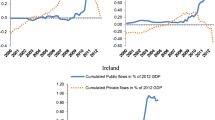Abstract
The introduction of the Euro in 1999 implied the transfer of the responsibility for monetary policy to the European Central Bank and it eliminated the member countries’ nominal exchange rates. The smooth operation of a common currency area requires that independent exchange rates are replaced by other adjustment mechanisms. In the Euro area, wages have not been flexible enough, labor mobility is low, no sufficient central fiscal institutions exist, and the fiscal rules have been weak. This led to large external imbalances and high public debt in some countries. Since the outbreak of the economic crisis, macroeconomic reforms resulted in improved international competitiveness and lower public deficits. Several new institutions have been created on the European level, strengthening mutual economic surveillance and cooperation.


Similar content being viewed by others
Notes
This section draws on Joint Economic Forecast Project Group (2013).
References
Allen, F., & Ngai, V. (2012). In what form will the eurozone emerge from the crisis? Journal of Applied Finance, 22(2), 6–19.
Bargain, O., Dolls, M., Fuest, C., Neumann, D., Peichl, A., Pestel, N., & Siegloch, S. (2013). Fiscal union in Europe? Redistributive and stabilizing effects of a European tax-benefit system and fiscal equalization mechanism. Economic Policy, July, 375–422.
Beck, Th., Wagner, W., & Uhlig, H. (2011). Insulating the financial sector from the european debt crisis: eurobonds without public guarantees, www.VOXeu.com/.
Beetsma, R., & Giuliodori, M. (2010). The macroeconomic costs and benefits of the EMU and other monetary unions: an overview of recent research. Journal of Economic Literature, 48, 603–641.
Blanchard, O., & Leigh, D. (2013). Growth forecast errors and fiscal multipliers. IMF working paper 13/1, http://www.imf.org/external/pubs/ft/wp/2013/wp1301.pdf.
Brunnermeier, M., Garicano, L., Lane, P. R., Pagano, M., Reis, R., Santos, T., Thesmar, D., van Nieuwerburgh, S. & Vayanos, D. (2011). European Safe Bonds (ESBies), www.Euro-nomics.com/.
Buiter, W., & Rahbari, E. (2011). The future of the euro area: fiscal union, break-up or blundering towards a ‘you break it you own it Europe’, Citigroup, Global Economics View, 9. September 2011.
De Grauwe, P. (2009). Economics of a monetary union. Oxford: Oxford University Press.
European Commission (2006). The EU economy: 2006 review. European Economy No 6/2006. Brussels.
European Commission (2012). European economic forecast, autumn 2012, (Box 1.5). http://ec.Europa.eu/economy_finance/eu/forecasts/2012_autumn/box_af12_-_multipliers_en.pdf. Brussels.
Feldstein, M. (2011). The Euro and European economic conditions, NBER Working Paper WP 17617.
Honkapohja, S. (2013), The Euro crisis: a view from the North. Bank of Finland Research Discussion Papers 12/2013.
Joint Economic Forecast Project Group (2013), German Economy Recovering—Long-Term Approach Needed to Economic Policy. Spring 2013. Halle (Saale).
Keuschnigg, Ch. (2012), Should Europe become a fiscal union?, CESifo Forum 1/2012, 35–43. Munich.
Lane, P. R. (2006). The real effects of European monetary union. Journal of Economic Perspectives, 20, 47–66.
Lane, P. R. (2012). The European sovereign debt crisis. Journal of Economic Perspectives, 26, 49–68.
Sapir, A. (2011). European integration at the crossroads: a review essay on the 50th anniversary of Bela Belassa’s theory of economic integration. Journal of Economic Literature, 49, 1200–1229.
Shambaugh, J. C. (2012). The Euro’s three crisis, brookings papers on economic activity, vol. 44, issue 1 (Spring), 157–231.
Sinn, H.-W., & Wollmershäuser, T. (2011). Target loans, current account balances and capital flows: The ECB’s Rescue Facility, CESifo Working Paper WP 3500. Munich.
Author information
Authors and Affiliations
Corresponding author
Additional information
The authors are grateful to comments by participants of the 2012 INFER Annual Conference in Pescara, Italy, where an earlier version of this paper was presented.
Rights and permissions
About this article
Cite this article
Keuschnigg, C., Weyerstrass, K. Macroeconomic Adjustment and Institutional Reforms in the Euro Area. Int Adv Econ Res 21, 275–285 (2015). https://doi.org/10.1007/s11294-015-9530-3
Published:
Issue Date:
DOI: https://doi.org/10.1007/s11294-015-9530-3




